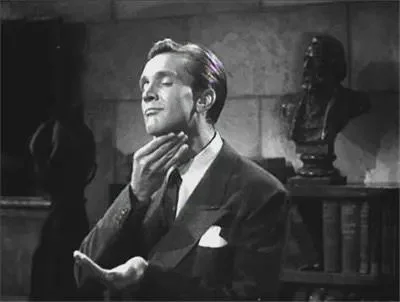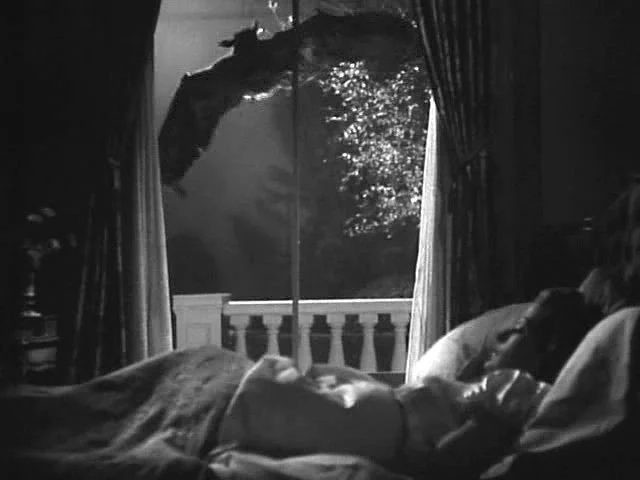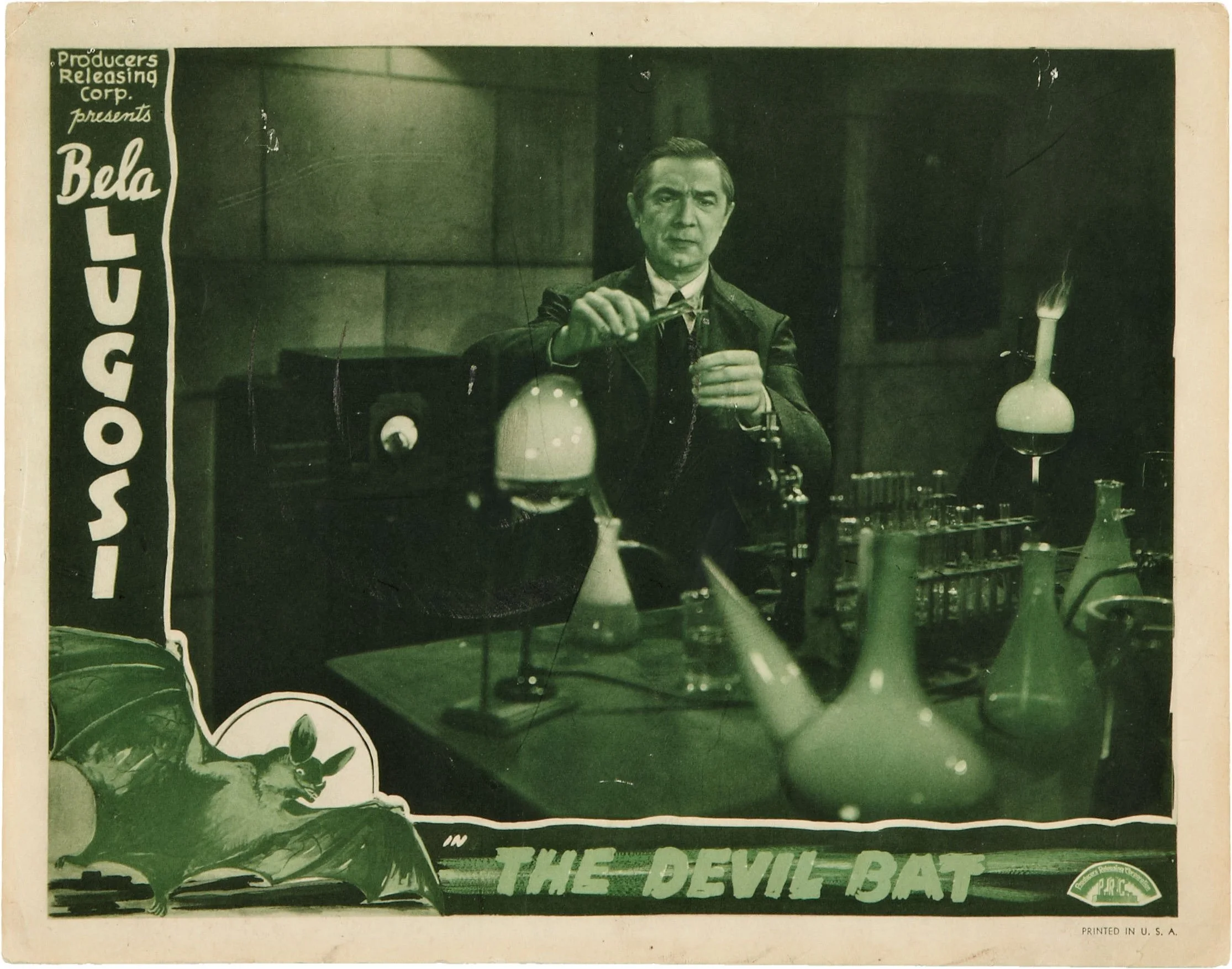A Scent to Die For: The Devil Bat (1940)
Believe it or not we are just past six months from the launch of Concentric Cinema and this is the first time we are covering a Bela Lugosi film! We promise to do better from here on . . .
While we could have started with one of his iconic roles in movies like Dracula (1931), White Zombie (1932), The Black Cat (1934), The Raven (1935), or Son of Frankenstein (1939), we decided that would be too predictable and frankly we are more nuanced than that. Instead, we will spend some time talking about the B-movie classic, The Devil Bat.
So, let’s get flapping, shall we?
Original poster art
A kindly doctor with a fiendish side hustle
Dr. Paul Carruthers (Bela Lugosi) is an affable village doctor who moonlights as a chemist for the successful cosmetics company Heath & Morton (H&M) in the town of Heathville. Through chemical wizardry, Carruthers has developed a highly successful line of cosmetic products, including after shave lotions and perfumes that have helped make H&M founders Henry Morton (Guy Usher) and Martin Heath (Edmund Mortimer) a fortune. Also benefiting from the H&M wealth are sons and presumed company heirs Don Morton (Gene O’Donnell), Roy Heath (John Ellis), Tommy Heath (Alan Baldwin), and Martin’s daughter Mary Heath (Suzanne Kaaren).
The Heath and Morton families live on a lavish estate with sprawling grounds, an opulent mansion, and a French maid by the name of Maxine (Yolande Donlan)—she being French makes it all the more fancy I suppose? While they are happy to lounge over cocktails and cigars, Dr. Carruthers has been stewing . . . big time.
Feeling as if he is not receiving the deserved recognition or financial compensation for the considerable contributions to the company’s success, Dr. Carruthers has grown bitter and angry. We learn that he is partly responsible for his situation; in the early days of the company he opted for a cash payment of $10,000 for his formula instead going in with Morton and Heath for a share in future profits which become considerable. Ouch!
Henry and Martin decide to present him with a bonus check for $5,000 to show their appreciation for his work. While they are tickled and quite self-congratulatory with what they see as a kind and generous gesture, this only enrages Dr. Carruthers further. Instead of taking his grievances directly to the founders, he decides on an “alternative” route by developing a new potently scented aftershave lotion as the instrument of his revenge.
And just how would an ultra-soothing and strong scented lotion be a tool of vengeance? Well, I haven’t yet told you about the bats. As it turns out, Dr. Carruthers has a secret laboratory in his hillside home overlooking the Heath estate. In this lab he essentially supersizes local bats by exposing them to powerful electrical impulses. We watch Carruthers as he studiously tweaks the voltage then looks on with a sense of deranged glee as the electricity sparks and his bats grow several times their original size—it’s a quintessential mad scientist moment that Lugosi delivers exquisitely and with great relish.
A little dab'll do ya . . . dead
After supersizing them, Carruthers gives the bats a big whiff of his new aftershave lotion, which fulfills two purposes: it elicits aggression in the animals but also serves as a target marker so that anyone who applies the lotion to their neck and throat area will become the bats’ next victim.
Carruthers asks members of the Heath and Morton families—or anyone else who runs afoul of the mad doctor—to sample the experimental lotion. Of course, he makes sure that the lotion is applied liberally near the jugular area under the guise of product testing. Well, you can see where this is going. Sure enough, these oversized bat assassins are sent out each evening to take out members of the Heath/Morton families. Once he is ready to take his leave after ensuring that his targets have essentially marked themselves, Dr. Carruthers always takes a solemn breath and says “goodbye” instead of good night. It’s a clever touch delivered brilliantly by Lugosi.
On the scent
It isn’t long before the events in Heathville attract outside attention. Enter jovial and slightly rebellious investigative reporter Johny Layton (Dave O’Brien) and his jolly if slightly daft photographer ‘One Shot” McGuire (Donald Kerr) of the Daily Register. The two are sent to Heathville by their blustering and cranky editor Joe McGinty (Arthur Q. Bryan) to report and even help solve the recent murders. Layton and One Shot ultimately team up with confounded police Chief Wilkins (Hal Price) to solve the mysterious murders with what clues they have: strange bite marks, animal hairs, and a peculiar odor lingering on the victims.
While local scientists and other experts are nowhere near close to solving the murders, Layton and One shot get to know Dr. Carruthers and both the Heath and Morton families. At the same time romance is in the air as Layton and Mary Heath seem be falling for one another while One Shot attempts an awkward courtship with the Heath family maid, Maxine.
Soon there are eyewitness accounts—including one by Layton & One Shot—of giant, screeching bats terrorizing the Heath estate. Layton starts to put the pieces together as he begins to suspect Dr. Carruthers, who outwardly projects nothing but affability and collegiality. Carruthers is supremely confident that he will be able to wipe out the entire Heath & Morton families. In several moments of sheer mad hubris he forgoes opportunities to steer the investigation away from the “devil bat” theory that has been making the rounds in the local papers. He even hints at his direct involvement, almost daring Layton and Chief Wilkins to figure it out.
My two cents
The Devil Bat features a few stilted performances, some clunky action sequences, and punchless dramatic scenes. Case in point: the film includes several scenes featuring run-ins with the devil bats, including sudden attacks, close calls, and violent deaths. However, our characters’ immediate reactions to these events are, in most instances, so casual and even downright flippant that it saps these moments of any dramatic impact.
With that out of the way, let me just say that I absolutely love this movie. While the sum of its flaws could be considered a major pox for what is ostensibly a horror film, it also ensures a tone that is consistently light, fun, and downright delightful despite the macabre proceedings.
Much of my enjoyment stems from Lugosi’s performance as the duplicitous, chip-shouldering Dr. Carruthers, one that breaths so much life into the film. By this time in his career, Lugosi had clearly perfected the embittered mad scientist, looking on adoringly at his bats while flashing a huge maniacal grin. Quite frankly, he nails it.
Sadly, as the decade went on Lugosi would experience mounting career and financial struggles due to substances abuse issues, language barriers, bad contracts, poor career decisions, unfair treatment from major studios, and typecasting. He would garner increasingly less prestigious roles, appearing in lower rent productions. That said, he never seemed to phone in a performance even in the roughest of productions including very late career appearances in notorious Ed Wood productions Glen or Glenda (1953) and Bride of the Monster (1955). While Lugosi passed away in 1956, he left us with so many memorable roles to enjoy in both great and not-so-great movies that we will be visiting in the future.
While the rest of the cast hardly gives Oscar-worthy performances, most seem to have understood the essence of the film: a low-budget and lighthearted monster movie with horror elements kept well in check by large helpings of light comedic banter. Dave O’Brien’s Johnny Layton and especially Donald Kerr’s comic relief One Shot Maguire simply refuse to let the murderous events get in the way of their good time. Arthur Q. Bryan’s Joe McGinty is also effective, playing up the classic (or clichéd?) irascible editor to the hilt as he browbeats, fires, and un-fires his reporters. For me, the weakest role is Mary Heath as played by Suzanne Kaaren. Hers is a very wooden performance, often delivering dialogue stiffly while looking off in one direction as if she might be reading off cue cards. It’s all very distracting.
And then there are those wonderful bats. Granted, they are not exactly built for realism as they hang suspiciously stiff in Carruthers’ lab and close ups shots of their heads reveal clearly inserted stock footage of actual fruit bats. That said, the filmmakers did a good job of giving the impression of the bats growing, first by simple cutaways to larger-looking bats but also by showing their wings slightly stretching as they pulse with electricity.
In terms of their flying, the bats have that traditionally awkward, clumsy flapping whenever they are hovering. Fans of classic horror B movies, the original horror soap opera series Dark Shadows, or any number of gothic-inspired Hammer films will recognize those endearing rubber bats. However, for their time these nocturnal killers look pretty good when they take flight and arc through the air. And the best part? As our devil bats dive towards their intended victims, they give out a shrill and suspiciously human-sounding scream that is equal parts hysterical and creepy—it makes me giddy every damn time. And let’s be honest: you would scare too if a bat with a three-foot wingspan was bearing down in your direction while emitting an anthropomorphic scream!
Considering the meager budget, the filmmakers also managed to render some very cool sets, including Carruthers’ laboratories, replete with bubbling beakers, test tubes of chemical concoctions, hidden doors, dark cobweb-covered passageways, and sparking electrodes. I especially enjoyed the little rope pulley he used to open the window from which the bats would escape at night on their bloodthirsty quests.
What The Devil Bat may lack in overall quality if makes up for in B movie charm, low-stakes horror fun, and the sheer joy of a vintage Lugosi performance. Plus it comes in at a very trim 79-minute run time, the type of economy that you know we at Concentric Cinema can always get behind.
Did you know?
The Devil Bat is considered a “poverty row” production. These were films that were produced cheaply by small, independent studios that churned out B movies, most of which were genre films, throughout the 1930s and 1940s. The majority of poverty row production companies set up shop in Hollywood’s Glower Street area.
The Devil Bat was one of the biggest hits for the poverty row company Producers Releasing Corporation (PRC). However, PRC let the copyright lapse, sending the movie into the public domain. The film became ubiquitous over the decades, running frequently on late-night TV and eventually on streaming services.
Actor Arthur Q. Bryan, who plays editor Joe McGinty, is probably best known for voicing the hapless hunter Elmer Fudd in the Looney Tunes cartoons of the 1940s and 1950s.
Lugosi was a founding member of the Screen Actors Guild.
There was a sequel to the film, The Devil Bat’s Daughter (1946). I haven’t seen it but from what I understand it has little-to-no continuity with the original movie.
How did I watch?
Kino Lorber blu-ray
Cast (abridged)
Bela Lugosi – Dr. Paul Carruthers
Suzanne Kaaren – Mary Heath
John Ellis – Roy Health
Dave O'Brien – Johnny Layton
Guy Usher – Henry Morton
Hal Price – Chief Wilkins
Yolande Mallott – Maxine
Donald Kerr – "One-Shot" Maguire
Arthur Q. Bryan - Joe McGinty
Alan Bald – Tommy Heath
Crew (abridged)
Director – Jean Yarborough
Producer – Jack Gallagher
Screenwriter – John Thomas Neville, based on a story by George Bricker
Director of Photography – Arthur Martinelli
Musical Director – David Chudnow
Producers Releasing Corporaton (PRC)
Production Design – Paul Palmentola
Music – David Chudnow
Running Time: 1h 8m
Recommendations Based on The Devil Bat
The Raven (1935)
The Invisible Ray (1936)
Man Made Monster (1941)
Supplements
10 Most Sinister Bela Lugosi Roles, Ranked (Screenrant)
Bela Lugosi: 10 Essential Films (BFI)




























